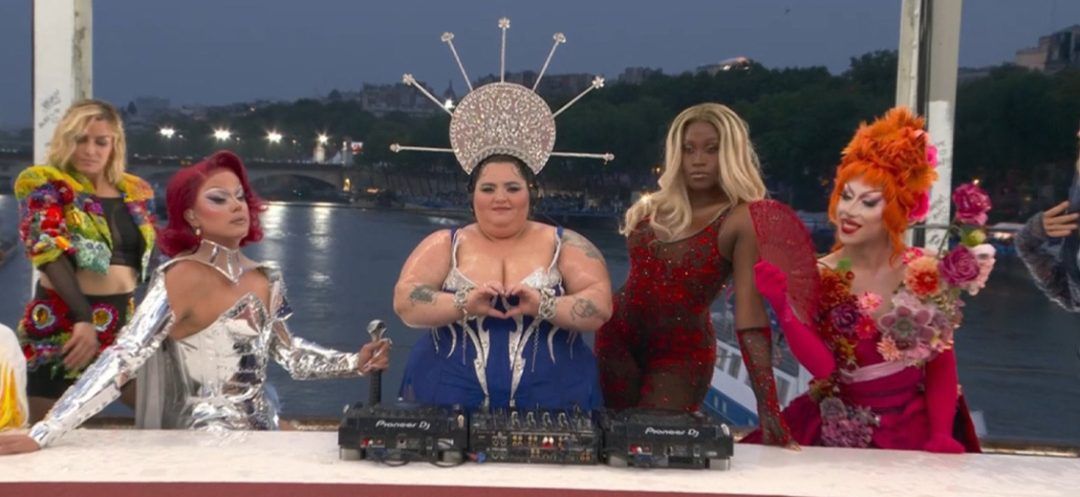
The much-anticipated opening ceremony of the Paris 2024 Olympic Games lived up to all its promises in terms of buzz and controversy. Baffling, breathtaking, provocative, this extraordinary inaugural event left no one indifferent. Here’s a look back at an XXL show that electrified social media and TV studios.
On Friday night, the eyes of the world were fixed on the Seine, transformed for the occasion into the longest floating stage in Olympic history. For nearly three hours, the scenes followed one another at a frenetic pace, in a lavish display of pyrotechnic effects, holographic projections, and futuristic technological feats. All of this was accompanied by an eclectic musical medley.
From the outset, it was clear: no, this ceremony would not resemble any other. Goodbye to stilted solemnity and immutable rituals. Hello to audacity, extravagance, and bold radicalism. A true visual UFO, somewhere between fashion week, the Berlin techno parade, and the Rio carnival. In short, an eccentric, excessive, radical, anarchic UFO.
But behind this grand aesthetic spectacle, what were the organizers trying to tell us? It was hard to unravel, as the messages, sometimes contradictory, collided throughout the evening. On one hand, a grandiose celebration of French universalism, on the other, pointed nods to contemporary community-driven issues and identity obsessions: drag queens, wokeism, cancel culture…
This desire to tick all the boxes of societal progressivism caused quite a few grumbles, even among the “progressives.” “Too much is too much,” “sometimes it verges on caricature, self-parody.” A highlight of the most divisive moments: the diversity-infused rewrite of national history, portrayed by “racialized” actors. Or this surprising queer reinterpretation of the Last Supper, an alleged reference to Biljert's “Feast of the Gods”, which infuriated traditional Catholics.
“An anti-Christian provocation,” seethed the far-right. “A magnificent slap to reactionaries,” applauded the far-left. Divisive, as you can see. Not to mention the totally baroque staging of the whole event, far, very far from the lyrical and figurative flights of the past. “Neoclassical,” “postmodern,” “post-apocalyptic”… The adjectives abound to attempt to describe this great aesthetic mess, a true hodgepodge of styles and influences.
From this creative melting pot emerged an ultra-aestheticized, almost anesthetizing image of French malaise. As if this visual debauchery sought to sublime wounds and fractures. By staging sad passions (to quote Spinoza) to the tunes of synthetic pop, the ceremony ultimately exorcised and transcended them. For one evening, it gave the illusion of a France reconciled with itself and its diversity.
For a few hours, this improbable opening ceremony managed to shift boundaries, push the limits of what can be said and shown. It offered a glimpse, for those willing to see, of the field of possibilities. After all, maybe that’s also the Olympic spirit: to surpass oneself, to aim always further, higher, stronger. Even if it means stumbling along the way.
And let’s admit it, the grand finale with Céline Dion was absolutely spectacular. The Quebec diva, perched at the top of the Eiffel Tower illuminated with a thousand lights, performed with palpable emotion “L’Hymne à l’amour” by Édith Piaf, her first stage appearance after four years of absence due to illness. A moment of pure grace and emotion that will remain etched in memories.
But beyond these grand lyrical flights, one question remains: does art have all the rights? Can everything be allowed in the name of the sacrosanct freedom of creation? Should we break free from all limits, all prohibitions, at the risk of hurting, shocking, offending?
This is the whole debate raised by this singular opening ceremony. By pushing the boundaries of convention, shaking up codes and traditions, it took the risk of excess, of extravagance. Even if it meant alienating part of public opinion, rekindling fractures and misunderstandings.
But isn’t it also the nature of art to disturb, to unsettle, to challenge our certainties and intellectual comforts? In this sense, this ceremony perfectly fulfilled its purpose. It was a mirror held up to our society, with its beauties and ugliness, its hopes and neuroses.
It is now up to each person to form their own opinion on this great artistic spectacle. To see it as a pinnacle of visionary avant-gardism or a worrying symptom of decadence. An ode to diversity or submission to community dictates.
Read more





Comments